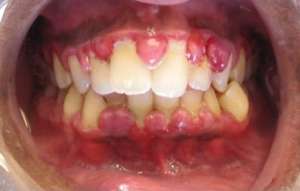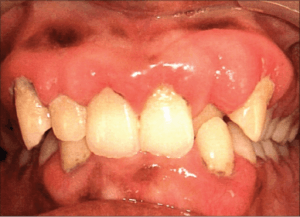Gingival hyperplasia

Inflammatory Gingival Hyperplasia

Gingival Hyperplasia from Diltiazem
Background
- Gingival Hyperplasia/hypertrophy main causes are inflammatory, drug-induced, or systemic
Clinical Features
- Swollen gums
- Bright red or purple
- +/- bleeding and easily bleed with probing
- Poor oral hygiene
Differential Diagnosis
- Inflammatory hyperplasia
- Gingivitis
- Poor oral hygiene and plaque retention
- Restorative and Orthodontic Applicances
- Drug Induced hyperplasia[1]
- Anti-convulsants (Phenytoin, Valproate, etc.)
- Immunosuppressants (Cyclosporine, Tacrolimus, etc.)
- Calcium channel blockers (Nifedipine, Amlodipine, etc.)
- Congenital Hyperplasia
- Systemic causes of Hyperplasia
- Periodontitis
Management
Disposition
- Treated outpatient
- Periodontal debridement, gingivectomy, laser surgery[4]
See Also
Dental Problems
References
- Bharti V et al. Drug-induced gingival overgrowth: The nemesis of gingiva unravelled. Journal of Indian Society of Periodontology. 2013;17(2):182-187. doi:10.4103/0972-124X.113066.
- Dahlen G et al. The effect of supragingival plaque control on the subgingival microbiota in subjects with periodontal disease. J Clin Periodontol. 1992;19:802–9.
- Pundir AJ et al. Treatment of drug-induced gingival overgrowth by full-mouth disinfection: A non-surgical approach. Journal of Indian Society of Periodontology. 2014;18(3):311-315. doi:10.4103/0972-124X.134567.
- Mavrogiannis M et al. The efficacy of three different surgical techniques in the management of drug-induced gingival overgrowth. J Clin Periodontol. 2006;33:677–82.
This article is issued from
Wikem.
The text is licensed under Creative
Commons - Attribution - Sharealike.
Additional terms may apply for the media files.